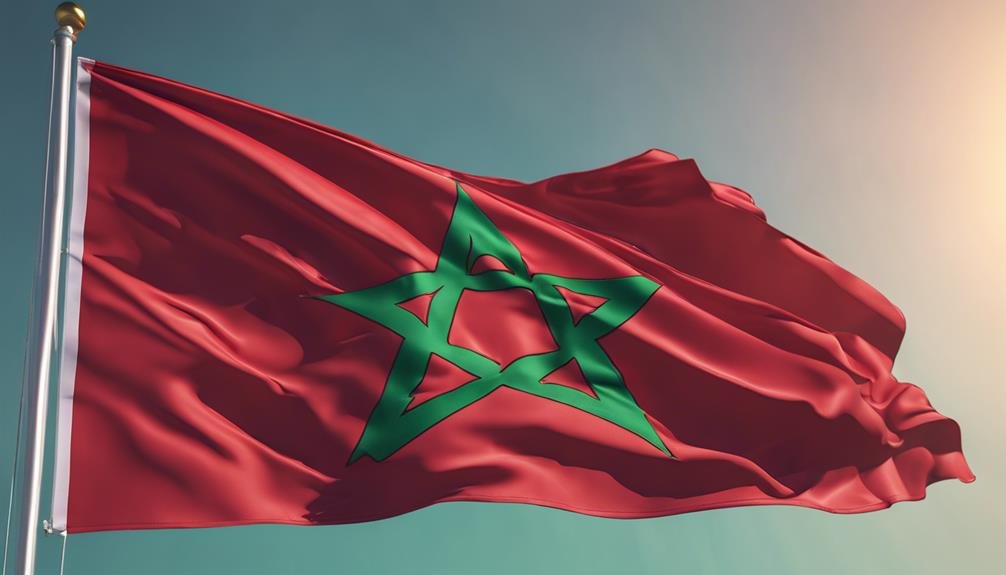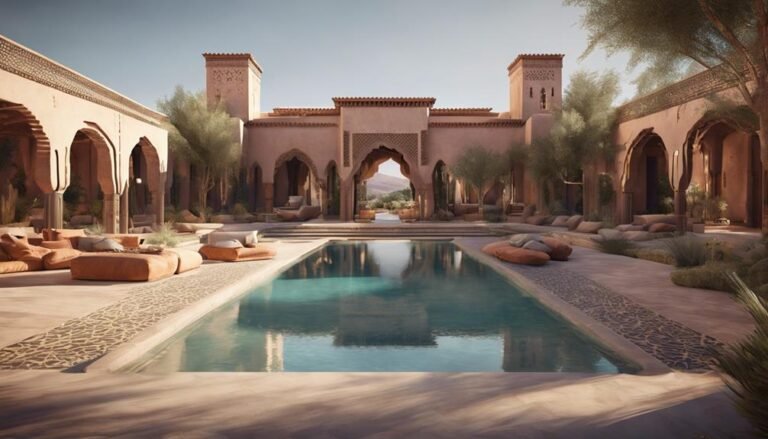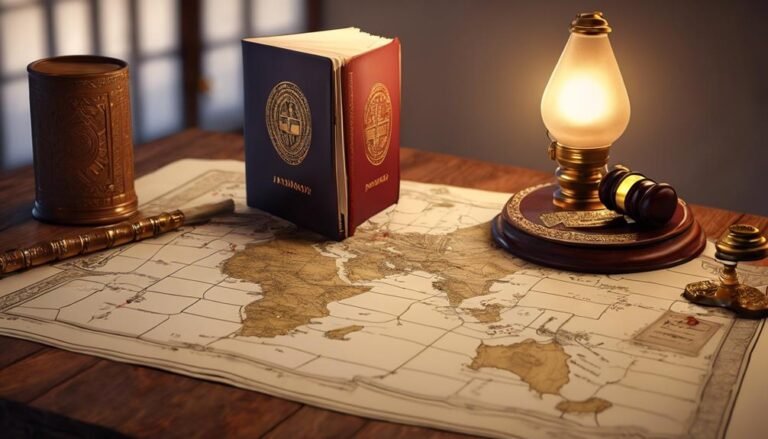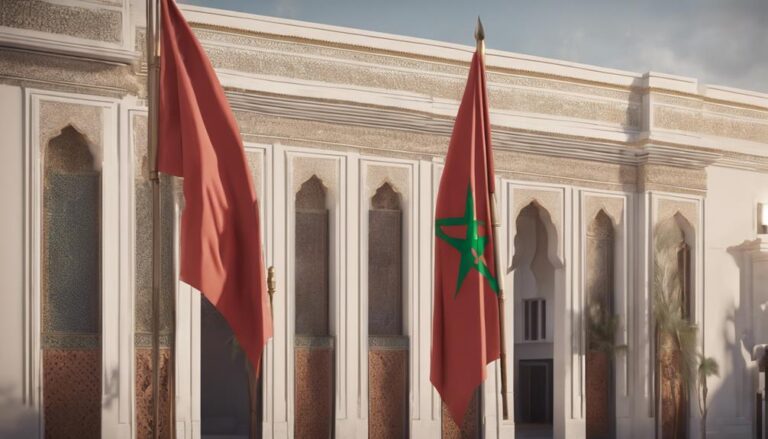The Moroccan flag holds deep significance, reflecting the nation's history and values. The red background symbolizes courage and strength, while the green pentagram embodies agricultural wealth and Islamic heritage. Each detail, from the Seal of Solomon to the five points of the star representing the pillars of Islam, fosters a sense of national pride and unity among Moroccans. Through its design and colors, the flag encapsulates the richness of Moroccan culture and identity. Explore further to uncover the intricate layers of symbolism that make the Moroccan flag a powerful emblem of heritage and patriotism.
Key Takeaways
- Represents bravery and strength with a vibrant red background
- Green pentagram symbolizes wisdom, wealth, and Islamic heritage
- Five-pointed star denotes the five pillars of Islam
- Fosters national pride and unity among Moroccans
- Evolves over time, reflecting cultural and political changes in Morocco
History of the Moroccan Flag
The origins of the Moroccan flag can be traced back to significant historical events that shaped its design and symbolism. The evolution of the flag mirrors the country's complex history and the struggle for independence. During the period of French and Spanish colonial rule in the early 20th century, the flag underwent several modifications to represent the changing political landscape. The historical context of Morocco's fight for independence against colonial powers influenced the design of the flag, with each element carrying deep symbolism.
The evolution of the flag can be seen as a reflection of the country's journey towards sovereignty and national identity. The red background, which dates back to the Alaouite Dynasty in the 17th century, symbolizes valor and bravery. The green pentagram represents the Seal of Solomon and is a nod to Morocco's historical ties to Islam. Understanding the historical context in which the Moroccan flag was born is essential to appreciating its significance and the values it embodies today.
Design and Colors Explanation
In tracing the roots of the Moroccan flag's design and colors, one can uncover a rich tapestry of historical significance and symbolism. The deep red background of the flag symbolizes valor and strength, reflecting the sacrifices made by Moroccans throughout history. This color choice aligns with color psychology, where red is often associated with courage and determination, highlighting the nation's resilience.
The green pentagram in the center represents the Seal of Solomon, a symbol of wisdom and unity. The choice of green, a color associated with growth and hope, signifies Morocco's agricultural wealth and Islamic heritage. The five points of the star represent the five pillars of Islam, further emphasizing the country's religious identity.
The design elements of the Moroccan flag come together to create a powerful visual representation of the nation's history, values, and beliefs. The combination of red and green, along with the pentagram, encapsulates Morocco's cultural richness and spiritual foundations. This flag serves as a proud emblem of the country's past and present, resonating with Moroccans and symbolizing their collective identity.
Symbolism Represented in the Flag
Explore the intricate layers of symbolism embodied within the Moroccan flag to uncover a profound narrative of history, culture, and faith.
The flag's vibrant red background symbolizes bravery, strength, and valor – key characteristics of the Moroccan people and their national identity.
The green pentagram in the center holds deep significance, representing love, joy, wisdom, and peace. This green pentagram also symbolizes the Seal of Solomon, an ancient emblem that has ties to King Solomon and his wisdom. Its presence on the flag reflects Morocco's rich cultural heritage and Islamic faith.
Additionally, the five points of the star can denote the five pillars of Islam, further emphasizing the country's religious identity.
The combination of the red background and green pentagram creates a visually striking symbol that's instantly recognizable and deeply meaningful to Moroccans, uniting them under a shared sense of national pride and heritage.
Evolution of the Flag Over Time
Exploring the historical context, the evolution of the Moroccan flag reveals a fascinating journey marked by changes reflective of the nation's dynamic cultural and political landscape. The flag has undergone notable transformations since its inception. Initially, during the Alaouite Dynasty, the flag featured a solid red background with no additional elements. It wasn't until the twentieth century that significant changes in design occurred. In 1915, a green pentagram was added to the flag, symbolizing the Seal of Solomon and the link to Islam. This alteration represented a shift towards a more religiously influenced design.
In 1956, following Morocco's independence, the flag went through another evolution. The green pentagram was replaced by a five-pointed star, representing the five pillars of Islam. The red background stayed consistent, signifying bravery and valor. This change in design highlighted Morocco's Islamic heritage and unity as a nation. Over time, these alterations in the flag's design have mirrored Morocco's cultural and political developments, embodying the country's rich history and values.
Cultural Impact and National Pride
As the Moroccan flag evolved over time, it became a powerful symbol deeply ingrained in the cultural fabric of the nation, fostering a sense of national pride and identity among its people. The flag's design, with its distinctive red background and green pentagram, holds significant cultural representation. The red background symbolizes hardiness, bravery, strength, and valor, essential qualities that Moroccans hold dear. The green pentagram represents the seal of Solomon, a symbol of wisdom and virtue. This symbolism resonates with Moroccans, instilling a sense of patriotic pride and unity. The flag is prominently displayed during national holidays, cultural events, and sporting competitions, serving as a unifying emblem that transcends regional differences and unites Moroccans under a common identity. The Moroccan flag's presence in everyday life reinforces a shared heritage and history, reminding citizens of their collective past and the values they hold dear.
| Cultural Representation | Patriotic Symbolism | Historical Significance |
|---|---|---|
| Red background symbolizes bravery | Green pentagram represents wisdom | Unites Moroccans under a common identity |
Conclusion
To sum up, the Moroccan flag serves as a vibrant emblem of the nation's rich history and cultural identity. Its intricate design and symbolic colors reflect the resilience and unity of the Moroccan people.
Through its evolution over time, the flag has become a powerful symbol of national pride and heritage. Its significance can't be understated, as it continues to represent the values and aspirations of the Moroccan society with grace and dignity.

The Editorial Team is a passionate group of Morocco enthusiasts dedicated to sharing the beauty, culture, and wonders of this captivating country. With diverse backgrounds and a deep love for travel, we strive to bring you engaging and informative content that inspires your Moroccan adventures. From uncovering hidden gems and sharing local insights to exploring mouthwatering cuisine and showcasing the vibrant lifestyle, our team is committed to providing you with valuable resources and exciting stories that enhance your exploration of Morocco. Join us on this journey as we celebrate the rich heritage and unforgettable experiences that make Morocco truly special.







